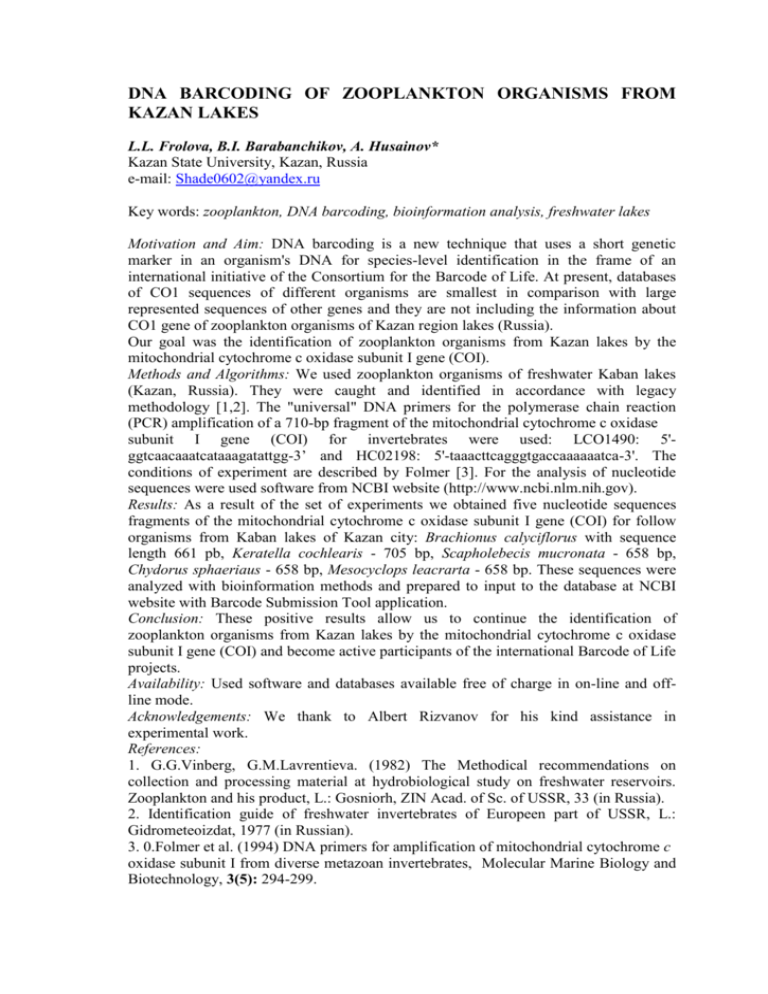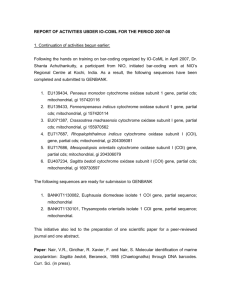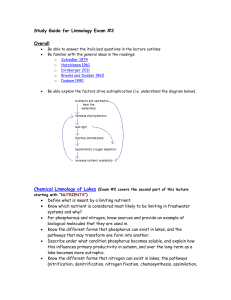DNA barcode of limnetic zooplankton organisms in Kazan lakes
advertisement

DNA BARCODING OF ZOOPLANKTON ORGANISMS FROM KAZAN LAKES L.L. Frolova, B.I. Barabanchikov, A. Husainov* Kazan State University, Kazan, Russia e-mail: Shade0602@yandex.ru Key words: zooplankton, DNA barcoding, bioinformation analysis, freshwater lakes Motivation and Aim: DNA barcoding is a new technique that uses a short genetic marker in an organism's DNA for species-level identification in the frame of an international initiative of the Consortium for the Barcode of Life. At present, databases of CO1 sequences of different organisms are smallest in comparison with large represented sequences of other genes and they are not including the information about CO1 gene of zooplankton organisms of Kazan region lakes (Russia). Our goal was the identification of zooplankton organisms from Kazan lakes by the mitochondrial cytochrome c oxidase subunit I gene (COI). Methods and Algorithms: We used zooplankton organisms of freshwater Kaban lakes (Kazan, Russia). They were caught and identified in accordance with legacy methodology [1,2]. The "universal" DNA primers for the polymerase chain reaction (PCR) amplification of a 710-bp fragment of the mitochondrial cytochrome c oxidase subunit I gene (COI) for invertebrates were used: LCO1490: 5'ggtcaacaaatcataaagatattgg-3’ and HC02198: 5'-taaacttcagggtgaccaaaaaatca-3'. The conditions of experiment are described by Folmer [3]. For the analysis of nucleotide sequences were used software from NCBI website (http://www.ncbi.nlm.nih.gov). Results: As a result of the set of experiments we obtained five nucleotide sequences fragments of the mitochondrial cytochrome c oxidase subunit I gene (COI) for follow organisms from Kaban lakes of Kazan city: Brachionus calyciflorus with sequence length 661 pb, Keratella cochlearis - 705 bp, Scapholebecis mucronata - 658 bp, Chydorus sphaeriaus - 658 bp, Mesocyclops leacrarta - 658 bp. These sequences were analyzed with bioinformation methods and prepared to input to the database at NCBI website with Barcode Submission Tool application. Conclusion: These positive results allow us to continue the identification of zooplankton organisms from Kazan lakes by the mitochondrial cytochrome c oxidase subunit I gene (COI) and become active participants of the international Barcode of Life projects. Availability: Used software and databases available free of charge in on-line and offline mode. Acknowledgements: We thank to Albert Rizvanov for his kind assistance in experimental work. References: 1. G.G.Vinberg, G.M.Lavrentieva. (1982) The Methodical recommendations on collection and processing material at hydrobiological study on freshwater reservoirs. Zooplankton and his product, L.: Gosniorh, ZIN Acad. of Sc. of USSR, 33 (in Russia). 2. Identification guide of freshwater invertebrates of Europeen part of USSR, L.: Gidrometeoizdat, 1977 (in Russian). 3. 0.Folmer et al. (1994) DNA primers for amplification of mitochondrial cytochrome c oxidase subunit I from diverse metazoan invertebrates, Molecular Marine Biology and Biotechnology, 3(5): 294-299.










